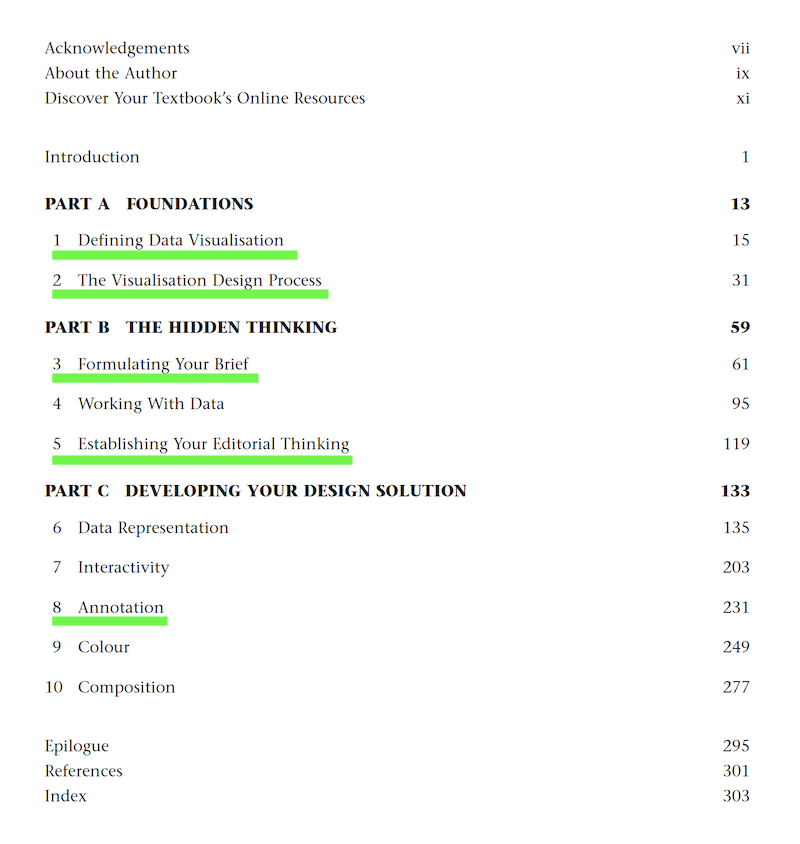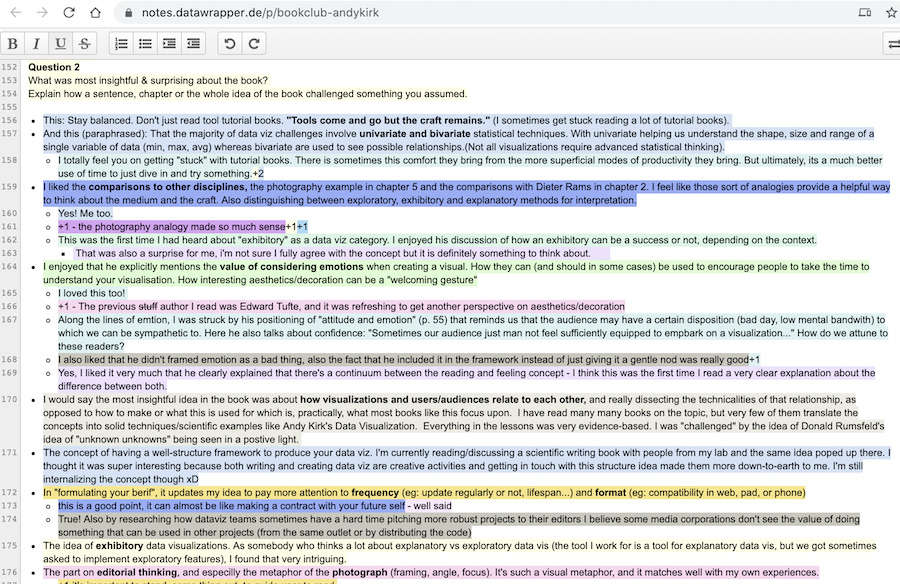'Data Visualisation: A Handbook for Data Driven Design'
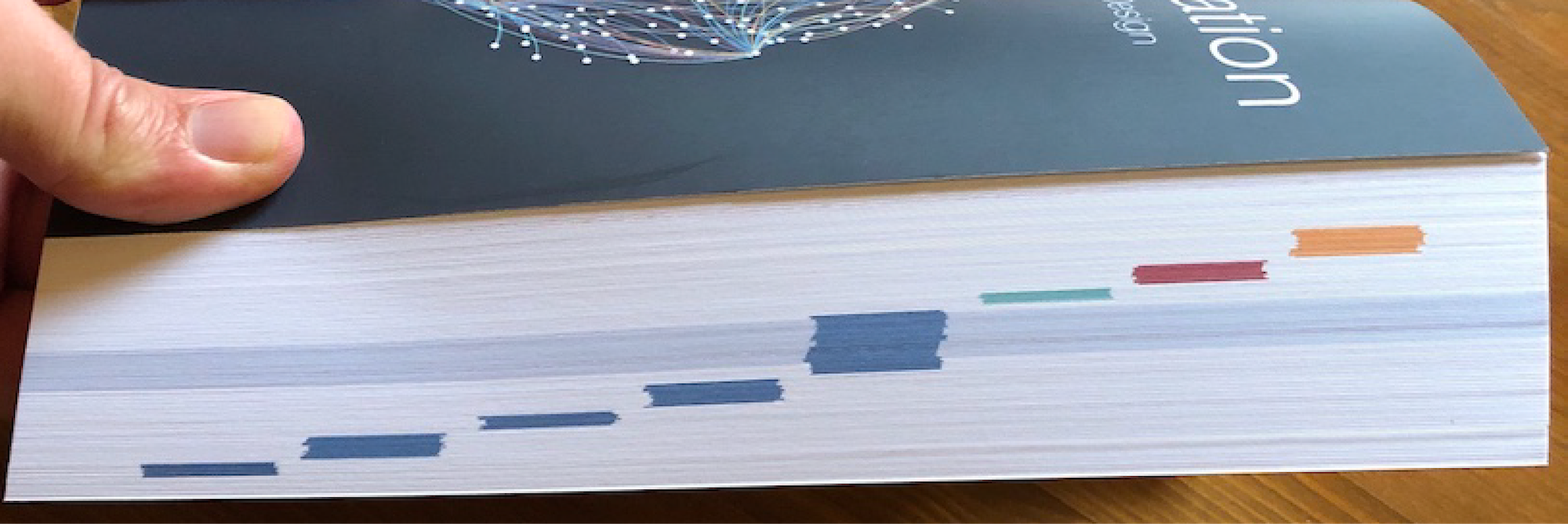
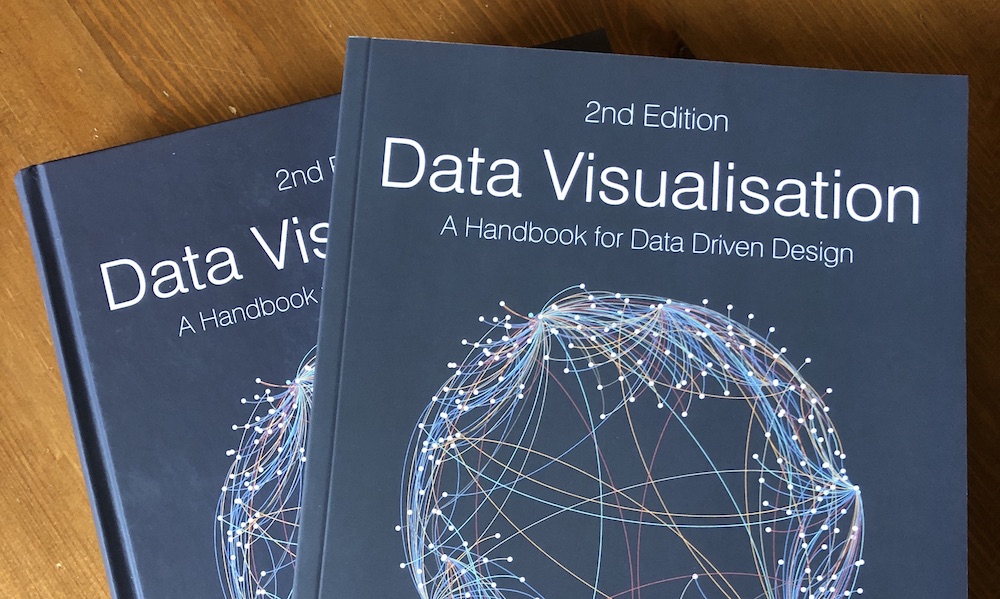
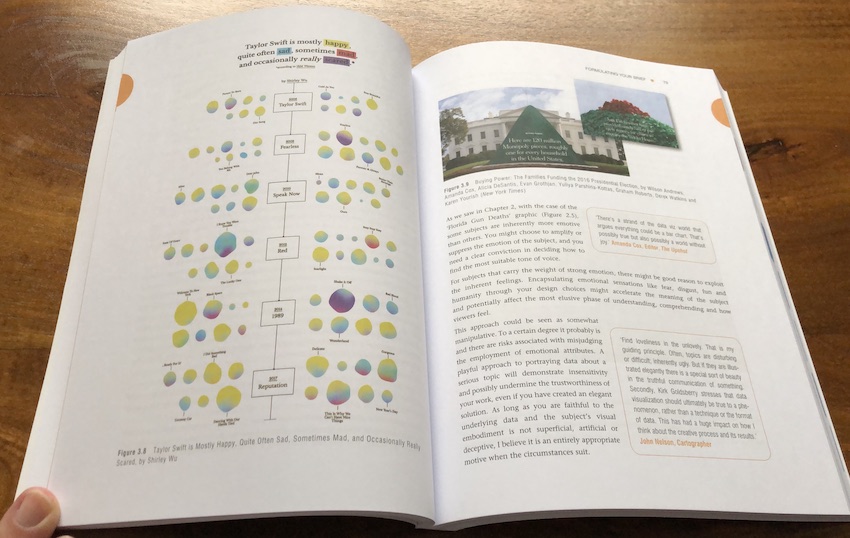

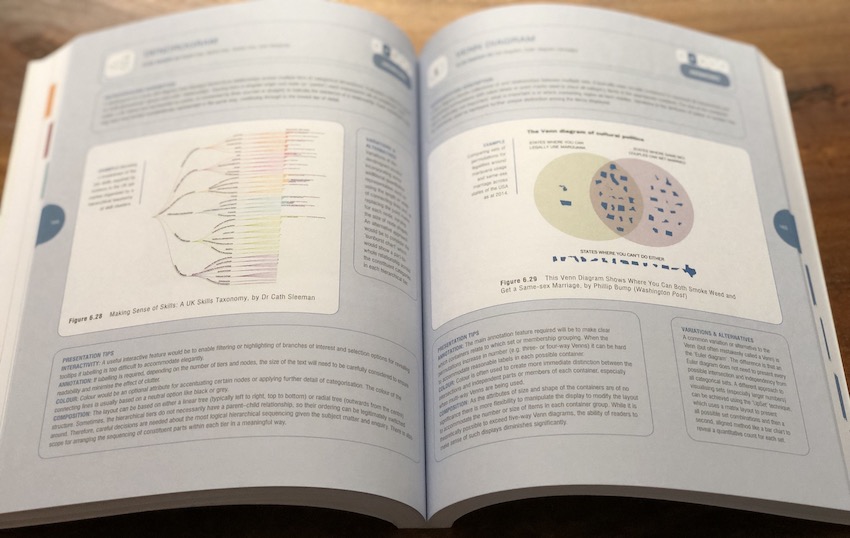
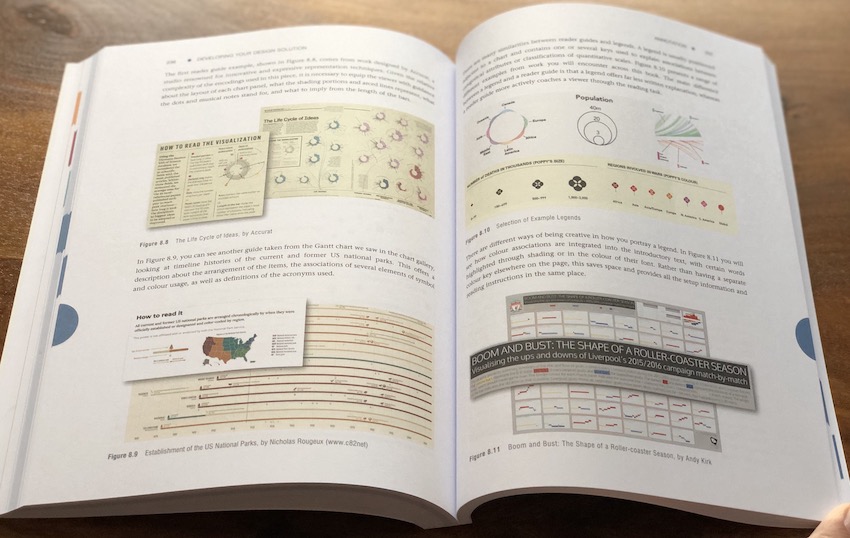
‘Data Visualisation: A Handbook for Data Driven Design’ is an award-winning second edition published by Sage in 2019. The aim of this book is to help people to become better visual communicators of data through the optimisation of creative, analytical and contextual decision-making.
The specific purpose of the second edition is to take the opportunity to make desired edits to the contents that reflect how my own convictions have evolved, and the way I communicate them, in the years that have passed since completing the first edition. Unless you are a committed completist collector of books, if you already have the first edition you may not need to also invest in this new edition, but certainly if you are buying this text for the first time this is the edition to go for.
Who is this Book For?
Objectives
The primary challenge one faces when writing a book about data visualisation is to determine what to leave in and what to leave out. Data visualisation is big. It is too big a subject to even attempt to cover it all, in detail, in one book. There is no single book to rule them all because there is no one book that can cover it all. Each and every one of the topics covered by the chapters in this book could, and indeed do, exist as whole books in their own right.
The secondary challenge is to decide how to weave all the content together. Data visualisation is not rocket science; it is not an especially complicated discipline: lots of it is rooted in common sense. It is, however, certainly a complex subject. There are lots of things to think about and decide on, as well as many things to do and make. Creative and analytical sensibilities blend with artistic and scientific judgments. In one moment you might be checking the statistical rigour of your calculations, in the next deciding which tone of orange most elegantly contrasts with an 80% black. The complexity of data visualisation manifests itself through how these different ingredients, and many more, interact, influence and intersect to form the whole.
I have arrived at what I believe to be an effective and proven pedagogy that successfully translates the complexities of this subject into accessible, practical and valuable form. I feel well qualified to bridge the gap between the large population of everyday practitioners, who might identify themselves as beginners, and the superstar technical, creative and academic minds that are constantly pushing forward our understanding of the potential of data visualisation. I am not going to claim to belong to that latter cohort, but I have certainly been the former – a beginner – and most of my working hours are spent helping other beginners start their journey. I know the things that I would have valued when I was starting out and I know how I would have wished them to be articulated and presented to me.
There is a large and growing library of fantastic books offering many different theoretical and practical viewpoints on the subject of data visualisation. My aim is to add value to this existing collection of work by taking on a particular perspective that is perhaps under-represented in other texts – exploring the notion and practice of a visualisation design process. It is my belief that the path to mastering data visualisation is achieved by making better decisions: effective choices, efficiently made. The aim of the book is therefore to help readers elegantly navigate through the process of what things to think about, when to think about them, what options exist and how to make the best choices.
Just as a single book cannot cover the whole of this subject, it stands that a single book cannot aim to address directly the needs of all people doing data visualisation. Here are some of the characteristics that shape the readers to whom this book is primarily targeted. This will help manage your expectations as a potential reader and establish its value proposition compared with other titles:
Domain, duties and level
The core audiences for whom this book has been primarily written are undergraduate and postgraduate-level students and early career researchers from social science subjects. This reflects a growing number of people in higher education who are interested in and need to learn about data visualisation. Although aimed at social sciences, the content will also be relevant across the spectrum of academic disciplines, from the arts and humanities right through to the formal and natural sciences: any academic duty where there is an emphasis on the use of quantitative and qualitative methods in studies will require an appreciation of good data visualisation practices. Where statistical capabilities are relevant so too is data visualisation.
Beyond academia, data visualisation is a discipline that has reached mainstream consciousness with an increasing number of professionals and organisations, across all industry types and sizes, recognising the importance of doing it well for both internal and external benefit. You might be a market researcher, a librarian or a data analyst looking to enhance your visual communication capabilities. Perhaps you are a skilled graphic designer or web developer looking to take your portfolio of work into a more data-driven direction. Maybe you are in a managerial position and not directly involved in the creation of visualisation work, but you might be seeking generally to improve the sophistication of the language you use around commissioning visualisation work and to have a better way of expressing and evaluating work created for you. Anyone who is involved, in any capacity, with the analysis and visual communication of data as part of their professional duties will need to grasp the demands of data visualisation and this book will go some way to supporting these needs.
The pitch of the book’s content is intended to serve the needs of beginners and those with intermediate capabilities. For most people, this is likely to be as far as they might ever need to go. It will offer an accessible route for novices to start their learning journey and, for those already familiar with the basics, there will be content that will hopefully contribute to fine-tuning their approaches. It is therefore not a book aimed necessarily at experienced or established visualisation practitioners. There may be some new perspectives to enrich their thinking, some content that will confirm and other content that might constructively challenge their convictions.
Handbook vs Tutorial Book
Technology is the key enabler for working with data and creating visualisation design outputs. Indeed, apart from a small proportion of artisan visualisation work that is drawn by hand, the reliance on technology to create visualisation work is an inseparable necessity. For many beginners there is an understandable appetite for step-by-step tutorials that help them immediately to implement data visualisation techniques via existing and new tools. However, it is important to be clear that this book will not offer teaching in the use of any tools.
Writing about data visualisation through the lens of selected tools is a bit of a minefield, given the diversity of technical options out there and the mixed range of skills, access and needs. I believe creating a practical, rather than necessarily a technical, text that focuses on the underlying craft of data visualisation with a tool-agnostic approach offers an effective way to begin learning about the subject in appropriate depth. The content should be appealing to readers irrespective of the extent of their technical knowledge (novice to advanced technicians) and specific tool experiences (e.g. knowledge of Excel, Tableau, Adobe Illustrator).
Useful vs Beautiful
I love flicking through those glossy ‘coffee table’ books as much as the next person; such books offer great inspiration and demonstrate some of the finest work in the field. This book serves a very different purpose, however. I believe that, as a beginner or relative beginner on this learning journey, the inspiration you need comes more from understanding what is behind the thinking that makes these amazing works succeed and others not. There is every hope that it will be seen as an elegantly presented and packaged book but my desire is to make this the most useful text available, a reference that will spend more time on your desk than on your bookshelf or your coffee table.
Pragmatic vs Theoretical
The content of this book has been formed through many years of absorbing knowledge from all manner of books, generations of academic papers, thousands of web articles, hundreds of conference talks, endless online and personal discussions, and lots of personal practice. What I present here is a pragmatic translation and distillation of what I have learned down the years. It is not a deeply academic or theoretical book. Where theoretical context and reference is relevant it will be signposted as I naturally wish to provide evidenced-based content wherever possible; it is about judging what is going to add most value. Experienced practitioners will likely have an appetite for delving deeper into theoretical discourse and the underlying sciences that intersect in this field but that is beyond the scope of this particular text. To accompany the book will be a digital companion site that will include many more references, articles, book and papers to substantiate readers’ knowledge of the subject.
Contemporary vs Historical
The subject matter, the ideas and the practices presented here will hopefully not date a great deal. Of course, many of the graphic examples included in the book will be surpassed by newer work demonstrating similar concepts as the field continues to develop. However, their worth as exhibits of a particular perspective covered in the text should prove timeless. As more research is conducted in the subject, without question there will be new techniques, new concepts, new empirically evidenced principles that emerge. There will be new thought-leaders, new sources of reference, new visualisers to draw insight from. New tools will be created, existing tools will expire. Some things that are done and can only be done by hand as of today may become seamlessly automated in the near future. That is simply the nature of a fast-growing field. This book can only ever be a line in the sand.
Looking back, we all respect the ancestors of this field, the great names who, despite primitive means, pioneered new concepts in the visual display of statistics to shape the foundations of the field being practised today. The field’s lineage is decorated by names and classic examples that frequent most books that have been written to date about this subject. Of course, to many beginners in the field, this historical context is of huge interest. However, again, this kind of content has already been superbly covered by other texts on more than enough occasions. Time to move on.
Data analysis vs Data communication
A final important distinction to make concerns the subtle but significant difference between visualisations which are used for exploratory analysis and visualisations used for communication. Exploratory analysis is a huge and specialist subject in and of itself. In its most advanced form, working efficiently and effectively with large complex data, topics like ‘machine learning’ become increasingly relevant. For the scope of this book the content is weighted more towards methods and concerns about communicating data visually to others. That said, Chapter 4 will cover the essential elements of the approaches to exploratory analysis in sufficient depth for the practical needs of most people working with data.
Hardback vs. Paperback
Hardback copies are produced and intended for libraries whereby there is a need to be a little more physically robust to protect the condition of the book for long term usage. Far fewer hardback copies are printed which means that the individual unit cost is higher than would normally be found with the higher volume print runs of the paperback version. Unless you absolutely want a hard cover I would urge everyone to look toward the soft cover paperback.
Book Contents
The book is organised into three main parts (A, B, and C) comprising ten chapters, a closing ‘Epilogue’ and an opening ‘Introduction’ to provide some initial context about the book’s content and structure.
Part A: FOUNDATIONS
Part A establishes the foundation knowledge and sets up a key reference of understanding that aids your thinking across the rest of the book. Chapter 1 will be the logical starting point for many of you who are new to the field to help you understand more about the definitions and attributes of data visualisation. Even if you are not a complete beginner, the content of the chapter forms the terms of reference that much of the remaining content is based on. Chapter 2 prepares you for the journey through the rest of the book by introducing the key design workflow that you will be following.
Chapter 1: Defining Data Visualisation
- Defining data visualisation: outlining the components of thinking that make up the proposed definition for data visualisation.
- The importance of conviction: presenting three guiding principles of good visualisation design: trustworthy, accessible and elegant.
- Distinctions and glossary: explaining the distinctions and overlaps with other related disciplines and providing a glossary of terms used in this book to establish consistency of language.
Chapter 2: The Visualisation Design Process
- The importance of process: describing the data visualisation design workflow, what it involves and why a process approach is required.
- The process in practice: providing some useful tips, tactics and habits that transcend any particular stage of the process but will best prepare you for success with this activity.
Part B: THE HIDDEN THINKING
Part B discusses the first three preparatory stages of the data visualisation design workflow. ‘The hidden thinking’ title refers to how these vital activities, that have a huge influence over the eventual design solution, are somewhat out of sight in the final output; they are hidden beneath the surface but completely shape what is visible. These stages represent the often neglected contextual definitions, data wrangling and editorial challenges that are so critical to the success or otherwise of any visualisation work – they require a great deal of care and attention before you switch your attention to the design stage.
Chapter 3: Formulating Your Brief
- What is a brief?: describing the value of compiling a brief to help initiate, define and plan the requirements of your work.
- Establishing your project’s context: defining the origin curiosity or motivation, identifying all the key factors and circumstances that surround your work, and defining the core purpose of your visualisation.
- Establishing your project’s vision: early considerations about the type of visualisation solution needed to achieve your aims and harnessing initial ideas about what this solution might look like.
Chapter 4: Working With Data
- Data literacy: establishing a basic understanding with this critical literacy, providing some foundation understanding about datasets and data types and some observations about statistical literacy.
- Data acquisition: outlining the different origins of and methods for accessing your data.
- Data examination: approaches for acquainting yourself with the physical characteristics and meaning of your data.
- Data transformation: optimising the condition, content and form of your data fully to prepare it for its analytical purpose.
- Data exploration: developing deeper intimacy with the potential qualities and insights contained, and potentially hidden, within your data.
Chapter 5: Establishing Your Editorial Thinking
- What is editorial thinking?: defining the role of editorial thinking in data visualisation.
- The influence of editorial thinking: explaining how the different dimensions of editorial thinking influence design choices.
Part C: DESIGN THINKING
Part C is the main part of the book and covers progression through the data visualisation design and production stage. This is where your concerns switch from hidden thinking to visible thinking. The individual chapters in this part of the book cover each of the five layers of the data visualisation anatomy. They are treated as separate affairs to aid the clarity and organisation of your thinking, but they are entirely interrelated matters and the chapter sequences support this. Within each chapter there is a consistent structure beginning with an introduction to each design layer, an overview of the many different possible design options, followed by detailed guidance on the factors that influence your choices.
Chapter 6: Data Representation
- Introducing visual encoding: an overview of the essentials of data representation looking at the differences and relationships between visual encoding and chart types.
- Chart types: a detailed repertoire of 49 different chart types, profiled in depth and organised by a taxonomy of chart families: categorical, hierarchical, relational, temporal, and spatial.
- Influencing factors and considerations: presenting the factors that will influence the suitability of your data representation choices.
Chapter 7: Interactivity
- The features of interactivity: (1) Data adjustments: a profile of the options for interactively interrogating and manipulating data. (2) View adjustments: a profile of the options for interactively configuring the presentation of data.
- Influencing factors and considerations: presenting the factors that will influence the suitability of your interactivity choices.
Chapter 8: Annotation
- The features of annotation: (1) Project annotation: a profile of the options for helping to provide viewers with general explanations about your project. (2) Chart annotation: a profile of the annotated options for helping to optimise viewers’ understanding your charts.
- Influencing factors and considerations: presenting the factors that will influence the suitability of your annotation choices.
Chapter 9: Colour
- The features of colour: (1) Data legibility: a profile of the options for using colour to represent data. (2) Editorial salience: a profile of the options for using colour to direct the eye towards the most relevant features of your data. (3) Functional harmony: a profile of the options for using colour most effectively across the entire visualisation design.
- Influencing factors and considerations: presenting the factors that will influence the suitability of your colour choices.
Chapter 10: Composition
- The features of composition: (1) Project composition: a profile of the options for the overall layout and hierarchy of your visualisation design. (2) Chart composition: a profile of the options for the layout and hierarchy of the components of your charts.
- Influencing factors and considerations: presenting the factors that will influence the suitability of your composition choices.
Epilogue
- This closing section of the book describes the production cycle, specifically the development activities that take place beyond the initial conceiving of a design specification.
Companion Website
An updated digital companion site has been constructed to provide readers of this book’s second edition with additional references and resources that will help to supplement their learning from the book’s content. To accompany each book chapter, there are four sections of contents for you to browse through: ‘Reading’, ‘Exercises’, ‘Case Study’, and ‘Figures’.
Explore the Field
The ‘reading’ contents offer a curated, and growing, collection of recommended links to web articles, papers and texts, and other relevant visualisation references associated with the topics covered by each chapter. They are provided to supplement the contents of the book and offer further perspectives that will build up your knowledge. The collection of reading materials will be refined as and when new references is discovered.
Try for Yourself
The ‘exercise’ sections offer a range of practical tasks for you to undertake to help substantiate your learning from the book. The nature of the challenges posed varies, with some involve sketching, several requiring you to evaluate visualisation design choices, and others relating to working with data. These exercises are for you to try out alongside the topics covered in each chapter of the book.
Data Visualisation in Action
The ‘case study’ contents provides a detailed behind-the-scenes write-up of a design process that went in to the development of a sample visualisation project. Initially, the case study will draw from the ‘Filmographics‘ project, created to demonstrate the practical application of the process proposed in the first edition of this book in 2016.
The Book’s Figures
The ‘figures’ sections provide details, links to the sources, and downloadable images relating to every figure published in the book. This will be especially useful for readers who are looking to incorporate figures from the book in to their teaching materials.
JAPANESE EDITION
In late 2020 I received news that a Japanese translation of the second edition of my book would be developed and produced by Asakura Publishing Co., Tokyo, Japan.
In July 2021 it was completed and published in Japan and made available to buy via amazon.jp.
It is a huge honour to have had my work translated and I’m so grateful to Toshiaki Kurokawa for his exceptional efforts in translating and adapting this for an entirely new audience.
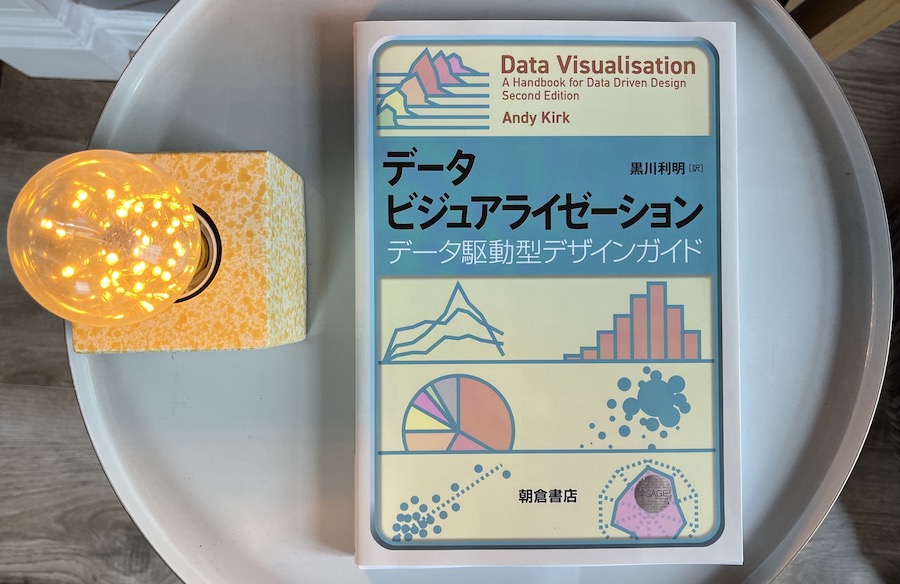
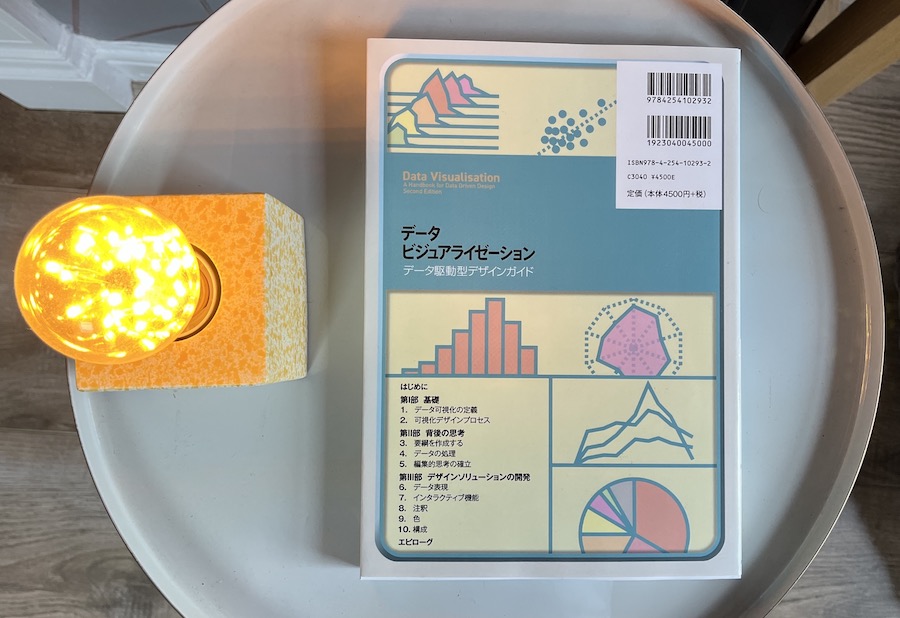
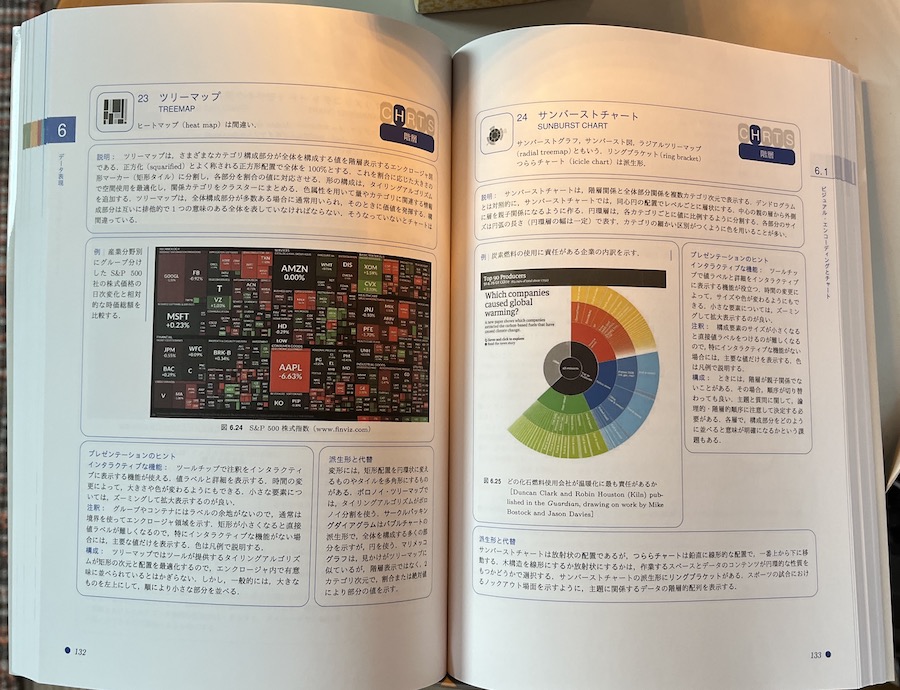
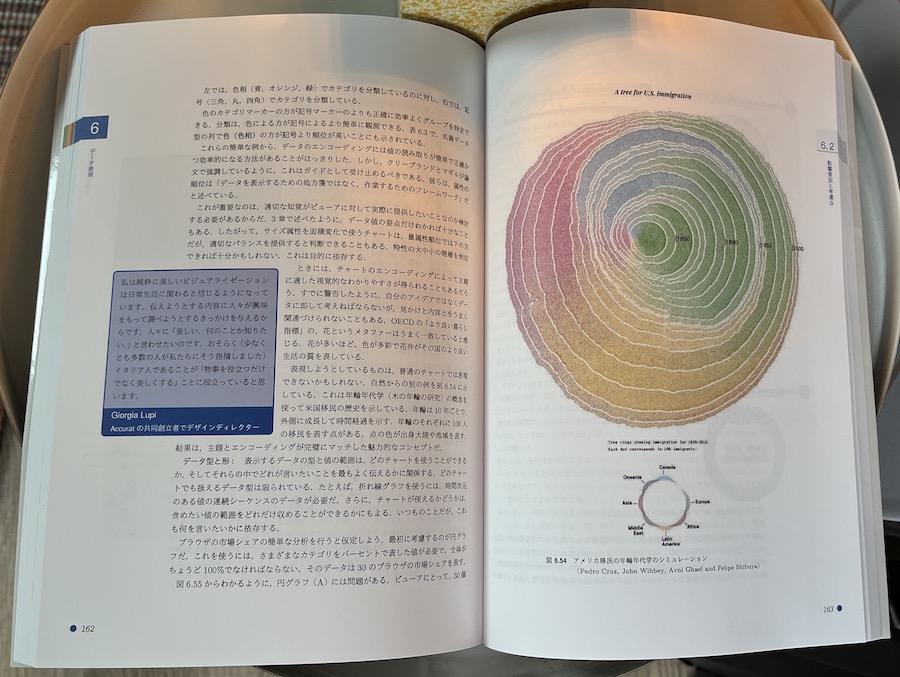
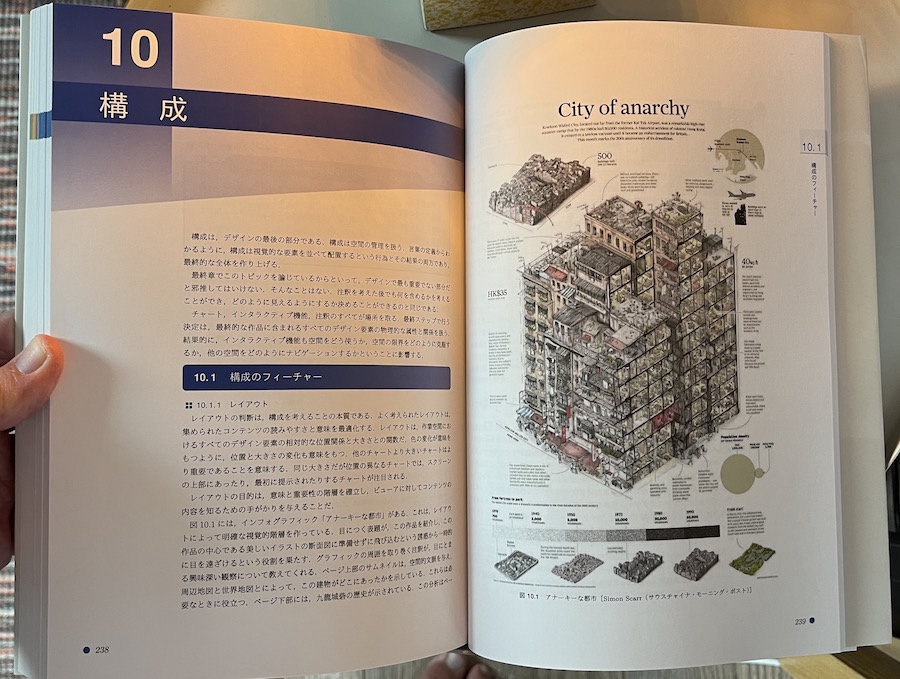
Data Vis Book Club
It was super to see the book chosen as the title to be discussed at the May 2020 ‘Data Vis Book Club‘, hosted and organised by Lisa Muth of Datawrapper.
Rather than attempt to cover the whole book, Lisa asked me to select five crucial chapters that are fundamental to or representative of the book’s aims. I selected chapters 1, 2, 3, 5 and 8. I was tempted by Chapter 6, as it is perhaps the literal and figurative centrepiece of the book, but it is a large chapter and for the scope of this book club I felt these selected chapters were better choices for discussing.
The three questions asked of reviewers were:
(1) What was your general impression of the book? Would you recommend working through it, and if so, to whom?
(2) What was most inspiring, insightful or surprising while you worked through the book? What did you learn that you didn’t expect to?
(3) Having read the book, what will you do differently the next time you visualize data?
Reviewers could then post their thoughts into a collaborative digital notepad to collectively build up a structured and constructive review.
Thanks so much to Lisa and all participants who joined the session, I really appreciate the many nice comments and astute observations about the things I wanted to convey through the book.
Errata
This is a list of discovered errors or typos included in the book’s text:
Page 18: In the third paragraph it currently says “positioned at the intersection of the relevant x and y positions for each reporting month and channel.”. ‘Channel’ is incorrect, this should say ‘percentage’.
Page 45: In the second paragraph there is stray phrase: “colour choices for the bars” (Thanks to Mike Leary).
Page 46: The following sentence should be ignored, as it is out of sequence in this edition: “In the Introduction’s glossary of terms, you will have seen the distinction between terms like complex and simple.”
Page 101: The list of examples should be of Ordinal categories, not Nominal as indicated (Thanks to Aida Amir Aslani).
Page 120: The passage that reads “The emphasis is clear. It is you who are ultimately responsible for the editing process” should be “The emphasis is clear: It is you who are ultimately responsible for the editing process”
Page 192: The passage that says “as supported by colour hue being ranked higher than shape for nominal data types” should state ‘symbol’, not ‘shape’.
Page 254: The line “There are two key factors to consider when judging your scales” should actually state there are ‘four’ key factors.


